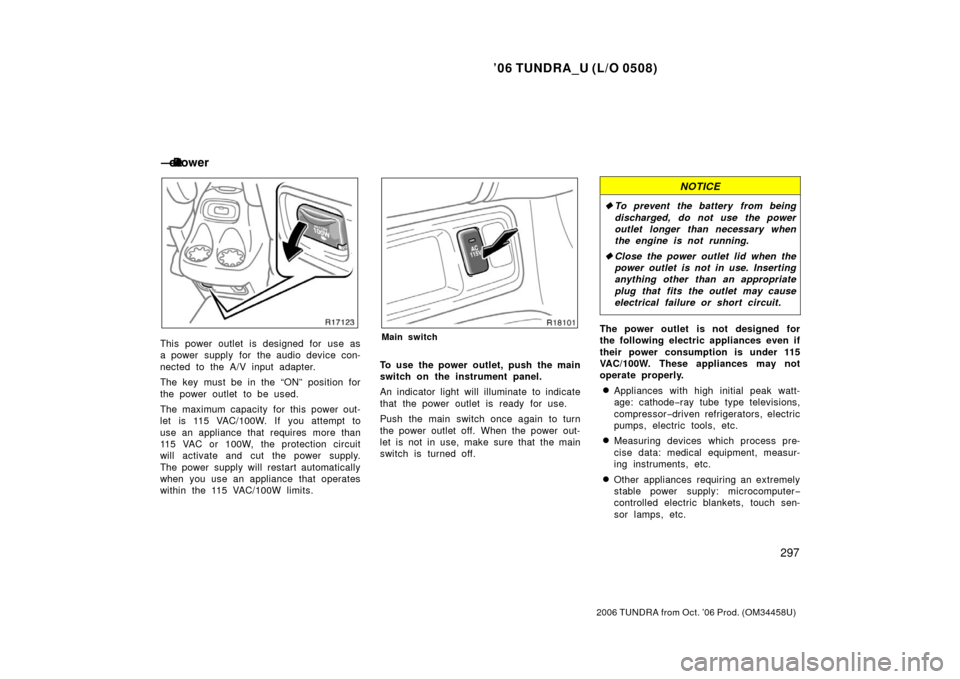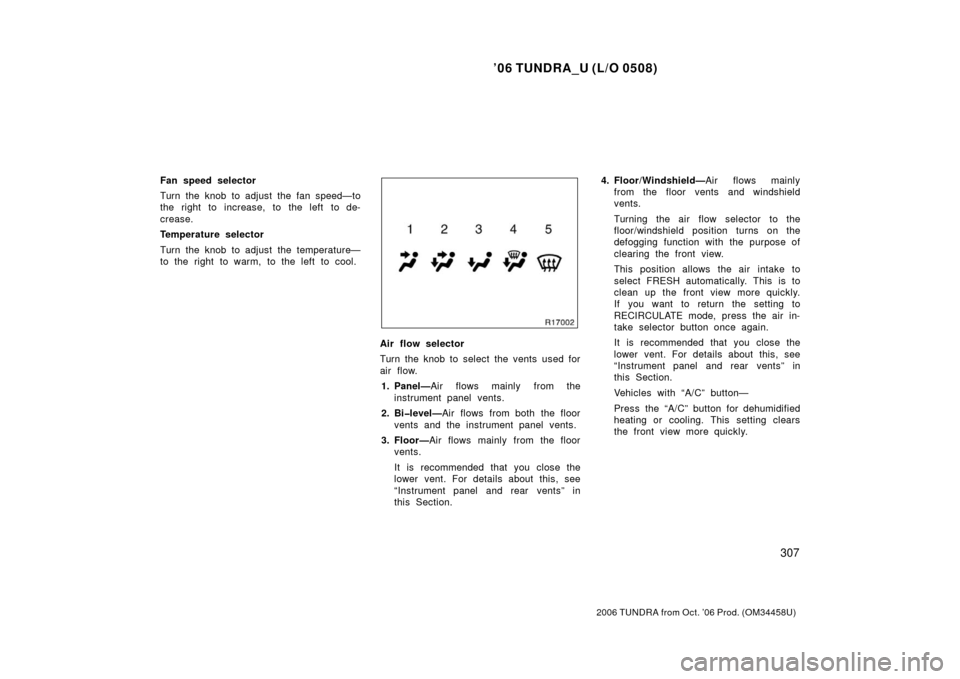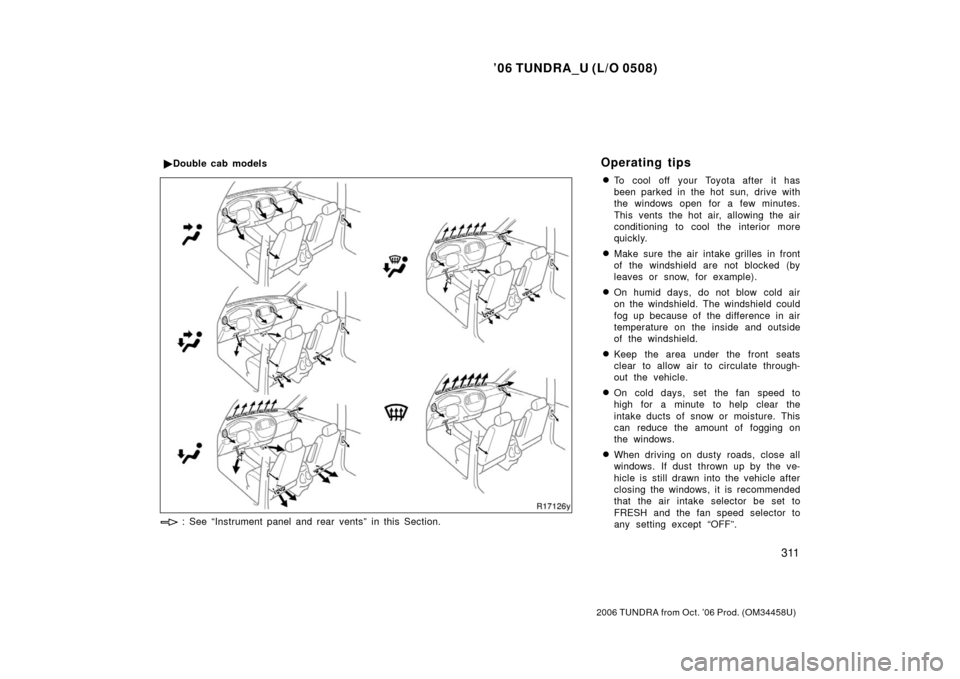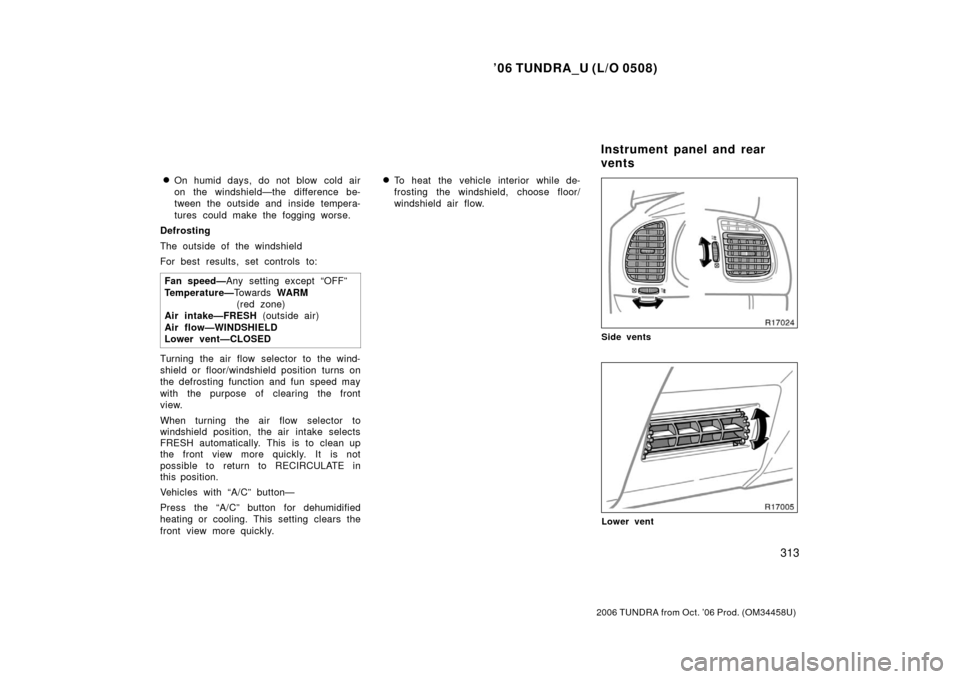Page 309 of 527

’06 TUNDRA_U (L/O 0508)
297
2006 TUNDRA from Oct. ’06 Prod. (OM 34458U)
This power outlet is designed for use as
a power supply for the audio device con-
nected to the A/V input adapter.
The key must be in the “ON” position for
the power outlet to be used.
The maximum capacity for this power out-
let is 115 VAC/100W. If you attempt to
use an appliance that requires more than
115 VAC or 100W, the protection circuit
will activate and cut the power supply.
The power supply will restart automatically
when you use an appliance that operates
within the 115 VAC/100W limits.Main switch
To use the power outlet, push the main
switch on the instrument panel.
An indicator light will illuminate to indicate
that the power outlet is ready for use.
Push the main switch once again to turn
the power outlet off. When the power out-
let is not in use, make sure that the main
switch is turned off.
NOTICE
�To prevent the battery from being
discharged, do not use the power
outlet longer than necessary when
the engine is not running.
� Close the power outlet lid when the
power outlet is not in use. Inserting
anything other than an appropriate
plug that fits the outlet may cause
electrical failure or short circuit.
The power outlet is not designed for
the following electric appliances even if
their power consumption is under 115
VAC/100W. These appliances may not
operate properly.
�Appliances with high initial peak watt-
age: cathode− ray tube type televisions,
compressor −driven refrigerators, electric
pumps, electric tools, etc.
�Measuring devices which process pre-
cise data: medical equipment, measur-
ing instruments, etc.
�Other appliances requiring an extremely
stable power supply: microcomputer −
controlled electric blankets, touch sen-
sor lamps, etc.
— ���
� �\b��
�
Page 317 of 527
’06 TUNDRA_U (L/O 0508)
305
2006 TUNDRA from Oct. ’06 Prod. (OM 34458U)
OPERATION OF INSTRUMENTS AND
CONTROLS
Air conditioning system
Controls 306
. . . . . . . . . . . . . . . . . . . . . . . . . . . . . . . . . . . . .\
. . . . . . . . . . . . . .
Air flow selector settings 309
. . . . . . . . . . . . . . . . . . . . . . . . . . . . . . . . . . . . \
.
Operating tips 311
. . . . . . . . . . . . . . . . . . . . . . . . . . . . . . . . . . . . \
. . . . . . . . . .
Instrument panel and rear vents 313
. . . . . . . . . . . . . . . . . . . . . . . . . . . . . .
SECTION 1� 9
Page 319 of 527

’06 TUNDRA_U (L/O 0508)
307
2006 TUNDRA from Oct. ’06 Prod. (OM 34458U)
Fan speed selector
Turn the knob to adjust the fan speed—to
the right to increase, to the left to de-
crease.
Temperature selector
Turn the knob to adjust the temperature—
to the right to warm, to the left to cool.
Air flow selector
Turn the knob to select the vents used for
air flow.
1. Panel— Air flows mainly from the
instrument panel vents.
2. Bi�level— Air flows from both the floor
vents and the instrument panel vents.
3. Floor— Air flows mainly from the floor
vents.
It is recommended that you close the
lower vent. For details about this, see
“Instrument panel and rear vents” in
this Section. 4. Floor/Windshield—
Air flows mainly
from the floor vents and windshield
vents.
Turning the air flow selector to the
floor/windshield position turns on the
defogging function with the purpose of
clearing the front view.
This position allows the air intake to
select FRESH automatically. This is to
clean up the front view more quickly.
If you want to return the setting to
RECIRCULATE mode, press the air in-
take selector button once again.
It is recommended that you close the
lower vent. For details about this, see
“Instrument panel and rear vents” in
this Section.
Vehicles with “A/C” button—
Press the “A/C” button for dehumidified
heating or cooling. This setting clears
the front view more quickly.
Page 320 of 527

’06 TUNDRA_U (L/O 0508)
308
2006 TUNDRA from Oct. ’06 Prod. (OM 34458U)
5. Windshield—Air flows mainly from the
windshield vents.
Turning the air flow selector to the
windshield position turns on the defog-
ging function with the purpose of clear-
ing the front view.
In this position, air intake selector
mode changes to FRESH automatically
to clean up the front view quickly. It is
not possible to return to RECIRCULATE
in this position.
It is recommended that you close the
lower vent. For details about this, see
“Instrument panel and rear vents” in
this Section.
Vehicles with “A/C” button—
Press the “A/C” button for dehumidified
heating or cooling. This setting clears
the front view more quickly.
For details about air flow selector settings,
see “Air flow selector settings” described
below. Air intake selector button
The air intake selector button is used to
switch the air intake
FRESH mode that
draws outside air into the system and
RECIRCULATED mode that recirculates
the air inside vehicle.
To turn the air source to RECIRCULATED
mode, press the button. The indicator will
come on. To turn the air source to FRESH
mode, press the button again. The indica-
tor will go off.
To prevent fogging up of the windshield,
the air intake mode may change automati-
cally to FRESH depending on the condi-
tion of the air conditioning system.
“A/C” button (on some models)
To turn on the air conditioning, press the
“A/C” button. The “A/C” button indicator
will come on. To turn the air conditioning
off, press the button again.
If the “A/C” button indicator flashes, there
is a problem in the air conditioning system
and the air conditioning automatically
shuts off. If this happens, take your
vehicle to a Toyota dealer for service.
Page 321 of 527
’06 TUNDRA_U (L/O 0508)
309
2006 TUNDRA from Oct. ’06 Prod. (OM 34458U)
Air flow selector settings
�Standard and access cab models without rear console box
: See “Instrument panel and rear vents” in this Section.
Page 322 of 527
’06 TUNDRA_U (L/O 0508)
310
2006 TUNDRA from Oct. ’06 Prod. (OM 34458U)
�Standard and access cab models with rear console box
: See “Instrument panel and rear vents” in this Section.
∗: On some models
Page 323 of 527

’06 TUNDRA_U (L/O 0508)
311
2006 TUNDRA from Oct. ’06 Prod. (OM 34458U)
�To cool off your Toyota after it has
been parked in the hot sun, drive with
the windows open for a few minutes.
This vents the hot air, allowing the air
conditioning to cool the interior more
quickly.
�Make sure the air intake grilles in front
of the windshield are not blocked (by
leaves or snow, for example).
�On humid days, do not blow cold air
on the windshield. The windshield could
fog up because of the difference in air
temperature on the inside and outside
of the windshield.
�Keep the area under the front seats
clear to allow air to circulate through-
out the vehicle.
�On cold days, set the fan speed to
high for a minute to help clear the
intake ducts of snow or moisture. This
can reduce the amount of fogging on
the windows.
�When driving on dusty roads, close all
windows. If dust thrown up by the ve-
hicle is still drawn into the vehicle after
closing the windows, it is recommended
that the air intake selector be set to
FRESH and the fan speed selector to
any setting except “OFF”.
�
Double cab models
: See “Instrument panel and rear vents” in this Section.
Operating tips
Page 325 of 527

’06 TUNDRA_U (L/O 0508)
313
2006 TUNDRA from Oct. ’06 Prod. (OM 34458U)
�On humid days, do not blow cold air
on the windshield—the difference be-
tween the outside and inside tempera-
tures could make the fogging worse.
Defrosting
The outside of the windshield
For best results, set controls to:
Fan speed— Any setting except “OFF”
Temperature— To w a r d s WARM
(red zone)
Air intake—FRESH (outside air)
Air flow—WINDSHIELD
Lower vent—CLOSED
Turning the air flow selector to the wind-
shield or floor/windshield position turns on
the defrosting function and fun speed may
with the purpose of clearing the front
view.
When turning the air flow selector to
windshield position, the air intake selects
FRESH automatically. This is to clean up
the front view more quickly. It is not
possible to return to RECIRCULATE in
this position.
Vehicles with “A/C” button—
Press the “A/C” button for dehumidified
heating or cooling. This setting clears the
front view more quickly.
�To heat the vehicle interior while de-
frosting the windshield, choose floor/
windshield air flow.
Side vents
Lower vent
Instrument panel and rear
vents